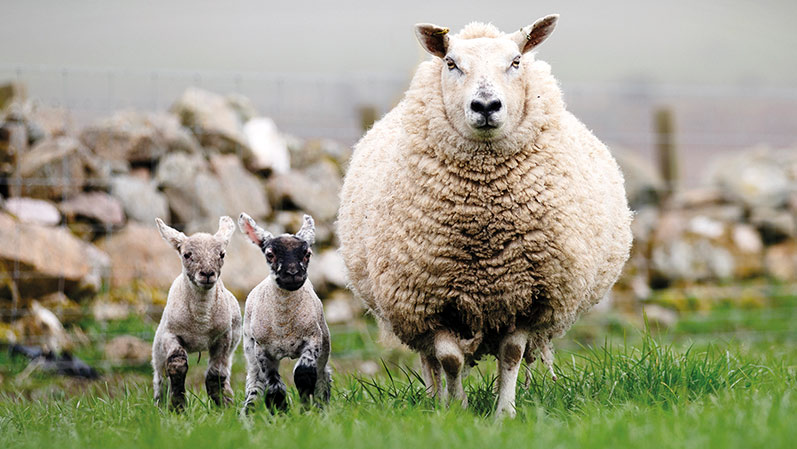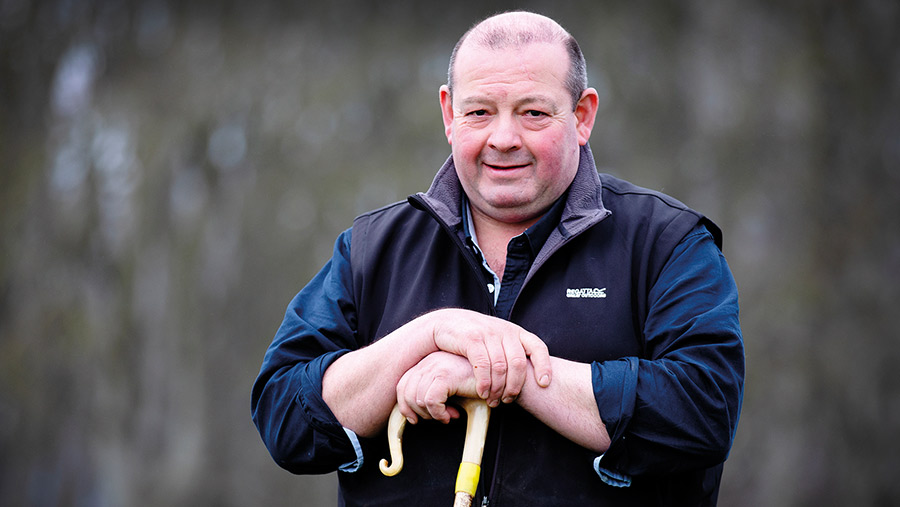Maedi visna outbreak leads to soul-destroying 4,000-ewe cull
 © Catherine MacGregor
© Catherine MacGregor Aberdeenshire stockman, Harry Emslie, suffered a cull of 4,000 ewes after maedi visna (MV) was discovered in his flock.
He had a soul-destroying autumn sending sheep to the local cull sale at Thainstone after discovering the disease in his lowland sheep in Kinknockie.
Falling lamb growth rates, elevated ewe mortality and thin, wasting ewes sent alarm bells ringing.
See also: Lower-cost MV scheme targets commercial flocks
He wants other farmers to be aware of how harmful MV is. “I thought MV was something that wouldn’t affect me,” he says.
“MV is awful. It hurts your production and profit, so it is best to know the problem, then you can sort it.”

Harry Emslie © Catherine MacGregor
How the disease spread
Mr Emslie and his two full-time shepherds had gone through an expansion and mindset change, from a traditional indoor lambing system to an extensive rotational grazing system.
The farm went from 400 to 4,000 ewes in six years, with 3,000 Aberfield-crosses based on Shetland ewes lambing in May and 1,000 Mules and Texel Mules lambing indoors in March.
The earlier lambed sheep provided cashflow and allowed the farm to buy ewes, retain replacements and expand, while still selling lambs in every month of the year.
Buying Shetland cross Cheviot ewes at Thainstone and Shetland for £50-£75, having three to four crops out of them to Aberfields and selling them for similar money was a cost-effective way to grow, explains Mr Emslie.
However, the indoor lambing flock was based on bought-in Mules and Texel Mules.
A batch of breeding ewes bought in autumn 2019 had MV, and, because they were housed in close confinement to lamb in the spring, the disease spread through all the indoor lambers.
This was a real kick in the teeth after making such progress in subdividing pasture, liming grassland, and seeing their preferred choice of genetics work so well, says Mr Emslie.
The farm was growing more grass with less fertiliser and running 1,300kg of liveweight/ha. Farm records showed 1.7 lambs reared and 90% finished off grass at 19kg deadweight.
Shepherds Jac Roberts and Mhari Macleod were fastidious about weighing lambs, monitoring growth rates and taking faecal egg counts.
The following observations flagged up the issue:
- Ewe mortality increased in spring 2022. It hit 8% in the indoor flock, compared with 1% in the outdoor flock
- Pre-weaning growth rates in certain groups halved from 300g to 150g a head/day
- Ewes struggled to regain condition post-weaning and were unable to improve on preferential grazing
Testing
In mid-July, Meadows Vets and post-mortem services from Scotland’s Rural College (SRUC) gave an on-farm presentation discussing flock health.
Four ewes from the indoor lambing flock were examined and taken away for analysis, and all were positive for MV.
The next step was to assess whether the disease had got into the outdoor lambers, so the tups and teasers were tested, along with 1,000 older, three- and four-crop ewes that were either home-bred or bought in.
The testing cost about £8,000.
Results showed all the tups and teasers and 20% of the ewes in every part of the farm had MV. Mr Emslie acted fast as he saw sheep rapidly “going downhill”.
Between August and September all the sheep were culled to cut losses, rid the farm of the disease, and recoup any value the sheep had.
“Instead of getting £130 a ewe, we sold many at £60 to £90 due to them already wasting with MV. We did our best with forage rape to get condition on them, but some only made £20.”
Warning for others
Mr Emslie then put Kinknockie on the market, with a view to moving back to the family’s home farm three miles away.
“We were lucky to have options, but the sheep at the scale we were running them could not continue,” says Mr Emslie.
“I wanted to buy MV-free stock and that would mean paying up to £240 for a shearling, which at an average of £70 for the cull ewes meant £680,000 to restock.
“This year would have been our last year of buying and we would have closed the flock,” he adds.
“MV has been a disaster for us and my message to farmers buying in sheep is to be aware of the risk and be very careful. I would not want anyone else to go through what we have.”
How to keep out maedi visna
Latest estimations suggest one in 10 flocks could have maedi visna (MV).
This means that dealing with the disease will be increasingly important in the coming years.
One challenge for farms not routinely testing is that MV is not picked up until production issues become obvious, by which point prevalence could have reached 20-40%.
Ewan Jamieson of Meadows Vets, Aberdeenshire, offers advice. There are two simple messages:
- If you don’t have it – make sure you keep it out
- If you suspect you might have it, don’t put your head in the sand as it costs you in lost performance
How do I keep MV out of my flock?
- Running a self-replacing flock with rams sourced from MV-accredited flocks is the best way to avoid iceberg diseases such as MV
- If buying in females, source from MV-accredited flocks
- SRUC runs two MV schemes. Some breeders in extensive hill situations cannot meet the full requirements of the MV Accredited scheme. For them, MV Monitored is a good second option
How can I test for MV in my flock?
- There are two ways – post-mortems and blood tests
- Post-mortems are a good way to monitor MV, as a good post-mortem vet will pick up other issues and other iceberg diseases, such as caseous lymphadenitis (CLA), ovine Johne’s disease (OJD), border disease (BD) and ovine pulmonary adenomatosis (OPA /Jaagsiekte)
- Blood tests can be taken quickly and can give a definitive answer, but they cost £5 to £7 a ewe and it can take six months for antibodies to MV to show up in blood.
- Several MV-accredited flocks have had disease breakdowns, but because they are monitoring the disease, they have picked it up early, before it has had a chance to spread
How do I select sheep for blood testing?
- Select sheep that are thin but with no obvious signs of issues such as mastitis or lameness, and with good teeth
- Flocks of 500 are advised to test 12 ewes, while larger flocks are advised to test 20
- Rams and teasers can often be MV spreaders – test at least five for every 500 ewes
Can I cull MV out of my flock?
- It is possible – but very hard – to manage MV out of your flock
- The cost of testing and the lost income from feeding thin, unproductive sheep is too much for many flocks to stand
- You must achieve two rounds of MV-free blood tests six months apart before you can consider yourself likely to have beaten the disease
- Housing sheep is a major transmission risk. Work by Moredun recently found housing for as little as two weeks is enough for MV to spread rapidly
- Systems intensively stocking (rotational grazing and strip feeding) are also likely to spread MV
